- The question that I would like to study is how does our interactions with our mobile devices change our perception of private and public space?
- The methods/ idea that I will engage to study this question is some research through design elements through a technology probe. I will also be referencing some of the ideas found in politics and design where we explored how we can expose the power implicitly in a technology.
- For the first week I will create a prototype of the probe I want to use in my study. I want to have a final prototype probe system by the middle of week one. Then during the second week have people interact with the probe and answer a series of questions about their feelings and thought while interacting with the probe. During the first week I will also need to compile a list of questions for participants to answer during and after their interactions with the probe. The prototype will involve some type of way to project what’s on our phone screens into the real world.
- I plan to document the work through photographs, video, and written documentation. I will share the process of creating the probe along with how people interact with the probe. I will also be documenting the participants’ responses to the questions.
Author: Jennifer Mah
Course Probes

The first probe I created was something that forced the participant to be creative. I asked the user to create a charm bracelet with at least 3 charms that represented childhood memories.
The response to my first probe (the charm bracelet) was good. The user drew 3 memories from their childhood. The first looks like a fire in the grass, then an experience at the swimming pool where the participant was drowning, and a memory about tetherball.
The next probe I used was using a sheet of tinfoil create a 3-D representation of the participant’s feelings about leaving home. The participant creates a small sculpture of a bed with a blanket.

The last probe I created was a blank piece of paper where I asked the user to draw their childhood bedroom and the neighborhood they grew up in.
The last response was the drawing of their childhood bedroom and the neighborhood they grew up in.

The design sketch I created to remind the participant about their childhood was a pen that had a tetherball attachment that would remind the user about the playful aspects of childhood while working.
Most of the responses aligned with what I expected. The response for the charm bracelet was expected because the instructions for the probe were quite specific. The goal of this probe was to create a probe that prompted the user to choose 3-4 events that were memorable from the user’s childhood. This gives us some insight into what experiences the user found the most memorable. If I were to improve this probe I would ask for a small description of some of the vague events that some of the charms depicted. I was surprised by the outcome from the second probe because it was so open ended. I was curious what the participant would create an actual item or just crumple up the tin foil or just rip the tin foil up. The item that the participant created was extremely intricate if I were to change anything about the probe process I would have asked the user to also include some words that could be associated with these feelings. The last probe’s answers were also expected. It allows us to gain some insight into what the participant’s life was like growing up based on if they shared a room or grew up in a city vs the Suburbs ect.
From the three probes that I created the best at revealing something about the person who completed the probe was the second probe. The participant had the ability to create anything they wanted to represent their feelings from the tin foil. I thought this was the most insightful probe because it allowed the user to physically show an emotion instead of trying to articulate their emotions in words. The option to physically sculpt or form these feeling allows different emotions to be interpreted from the probe results that the user might not even be conscious of.
Material Studies
I brought string as the material that I studied. I designed a couple actuators/sensors that utilized some of the material traits I found while studying my material. The first design was a device that could 3-d print with sting. My idea came from wanting to have the touch feel aspects of a physical form of an image I saw on my mobile device . One of the traits I found string possessed was that the material tended to be quite malleable and would allow for multiple layers of string to be laid on top of each other to create a physical form. Another sensor that I thought of was a physical representation of a todo list. As the items got checked off the list the string would unwrap to physically mark your achievements. This would allow the user to have a sense of accomplishment and understanding of the tasks completed on the list.
During our investigation of the materials the flow did become present because I stopped thinking about how the material behaved as string and let it express itself through its traits. By throwing it around and experimenting with the string I got to see another side to what the material could do and what tasks it could perform. For example while holding up the string to the light I could see that the ends of the string were unraveling which led me to think about how string could display different types of information.
Some of the benefits to starting design by working with a specific material is it forces you to be creative. By forcing designers to adhere to a specific material they must really consider the capabilities and limitations of the material assigned to them. It could also later on contribute to a solution for some of our environmental problems. What if designers could only use plastic bottles and plastic bags to create their designs. Would there be a reduction of items that go to waste? A limitation of designing around a material is that material might be limited on its capabilities to perform the task you want to perform.
Perception Studies
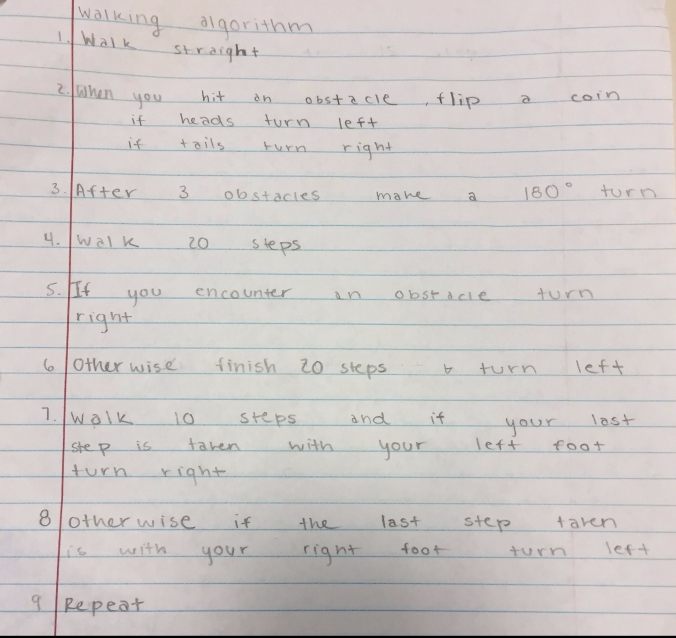
My intentions with the walking algorithm that I designed was for the user to take their time walking through campus and consider the various areas that could be explored if we used paths that we do not normally consider the most ‘efficient’ way to get to our destinations. The algorithm I designed worked because it force the user to follow the instructions given in the algorithm rather than using the most efficient path to get to a location.
When walking with the algorithm instructions I realized how various steps can be interpreted. For example what constitutes an obstacle? Is it any time we physically cannot move forward or is it when our step pattern is interrupted? This became evident when I encountered a set of stairs. Is this an obstacle because it interrupts my walking pattern or can I continue on my path because it physically does not block me from walking forward? While I assumed that stairs were obstacles for the first 15 minutes I quickly found myself trapped in the plaza above the steps leading down to Duane field. It took about 10 minutes to eventually use the other sidewalk to proceed out of the plaza. This process also allowed me to see some of the social expectations that people have when walking in public areas. While I was stuck in the plaza I had a few students ask if I was lost and needed help getting to a certain building. I also received multiple stares for walking back and forth through the plaza. The alogorith brought these things to my attention becuase it forced me to slow down and take the time to follow the algorithim’s instructions. It brought me to locations that I have previously never visited on campus.
This is a phone the projects your phone screen as a physical hologram when you use your device.
An aspect of the users lifeworld that is amplified by my new design is our society’s focus on always having social connections to our peers. With a projected screen of our mobile devices people would become more aware of how often we rely on our mobile devices as a form of social status and connection. With everything on our phones being projected as a hologram people become aware of how often we use technology throughout the day because the sheer amount of projected items through would encounter.
A script that might describe what behavior is evoked in the user when they use my new technology is a user using their phone less often in public. By projecting what is traditionally kept private on our phones into a public space people are less likely to use their phones in public. Since we want to keep most of the things viewed on our phone private users will be forced to only check their phones in private areas if they want to keep their mobile activities private.
Future Product Catalog
My catalog showcased various luxury home goods. The main focus of the catalog was to sell furniture and other furnishing items that could be used in a customer’s home.
- Invisible technology:
- Tables can charge mobile devices and laptops
- TV that looks like a framed painting until it is turned on
- Sustainability technology:
- Lamps that tweet about energy consumption
- Items made completely out of recycled items
- Other technology:
- Mirrors that can show the effect of different hazards on a user’s skin (sun damage, smoking, etc.)
- Furniture that monitors the user (bed that analyzes sleep patterns and amount of pressure on certain pressure point and changes to give the correct support.
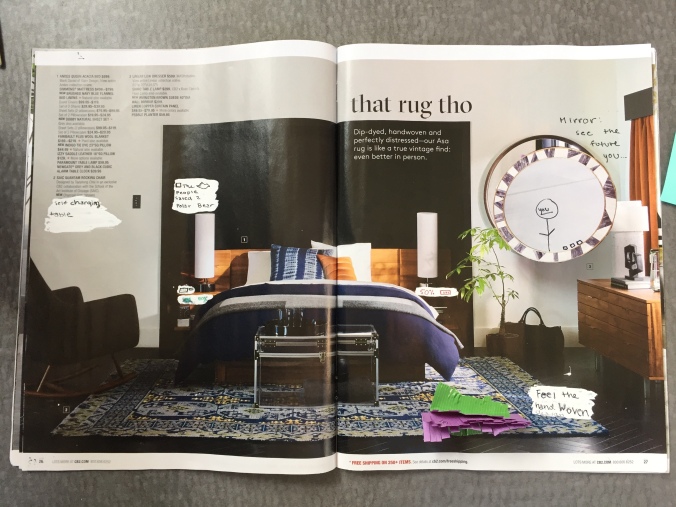
Some of the issues that I considered when designing my future catalog that I didn’t consider before was the fact that furniture can have a huge impact on the way we live our lives. I questioned whether ‘smart’ furniture would benefit mankind or if it would condition us to become reliant on these technologies to function. If I had more time I would improve my design fiction by refining how I displayed the future technologies. I would change my catalog to implement more touch and feel opportunities. This allows the user to have more access to how these future technologies work. The desired outcome from this design fiction was to show users how these future technologies could be implemented in a customer’s home through the look and feel of the product. This would provoke more sales and a better understanding of the product being purchased.
Subversion Exercise
List of tracking technologies used in different aspects of people’s lives:
- Credit cards
- Social media location checkpoint
- Google maps
- Cookies tracking from shopping online
- I-phone messaging tracking location to send to friends

A map that shows the amount of times a location has been visited by the size of the googly eyes and the time a user visited the location. The drop down menu shows the different apps that want to use this data and has a feature that allows you to deny access to location settings.
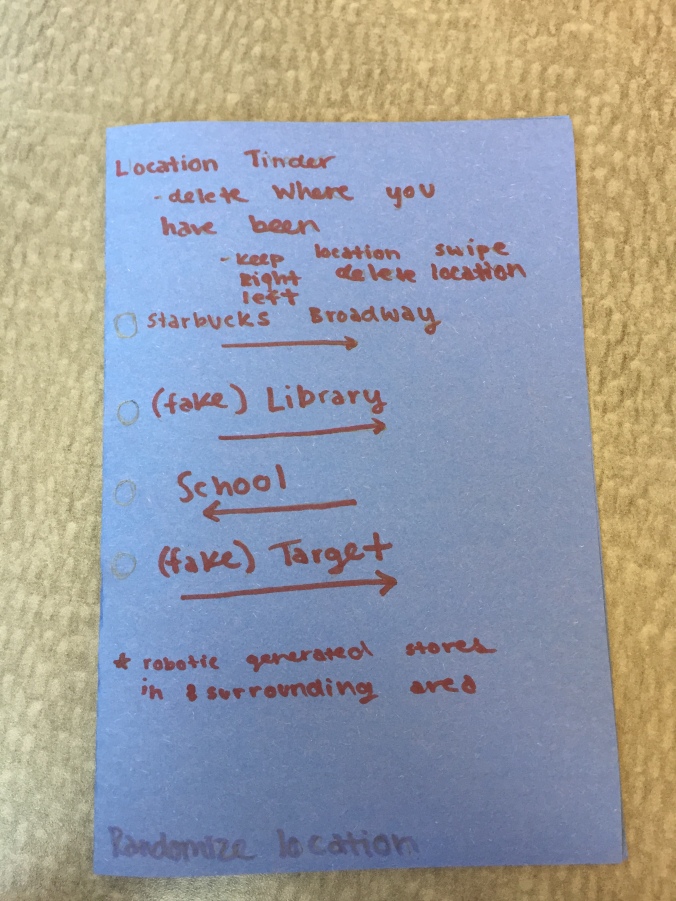
Location tinder: the location tinder tracks the locations that you have visited and allows users to delete locations that they do not want to share. It will also have a feature that suggests places in the surrounding area that you might want to include as location pins. For example if you wanted to look studious adding a the library and the school campus to your location list during that day will allow users to present their ‘best’ location settings.
I think the design that does the best job at creating a space for contestation is the first sketch with the map that shows the different locations that the user visits and what time they visit these locations. The design notifies users of other apps that want to track the user’s location. I think this design is the best way to create contestation because it allows the user to analyze the data collected and make their own conclusions. This means that users can block location settings from being used in certain apps. The user and various companies are involved in this contestation because companies want data on their users so that they can subliminally show users advertisements. If this design was implemented users could control what information was shared with these large companies and corporations. Some conversations and outcomes from this technology would be users becoming more aware of who and what companies want to track. This technology would be effective to people who are curious about how their search history and technological habits are being monitored but I believe in order for it to truly be provoking to create contestation is if companies obviously displayed these known facts about the user in advertisements. If companies became bolder with their approach to selling by including personal facts about the user I believe that the map technology would become a well-used commodity for people.
Parking Gates

These gates are material objects that prevent certain cars from entering specific parking lots by blocking the road until it is triggered to raise the arm by a transmitter given to certain drivers.
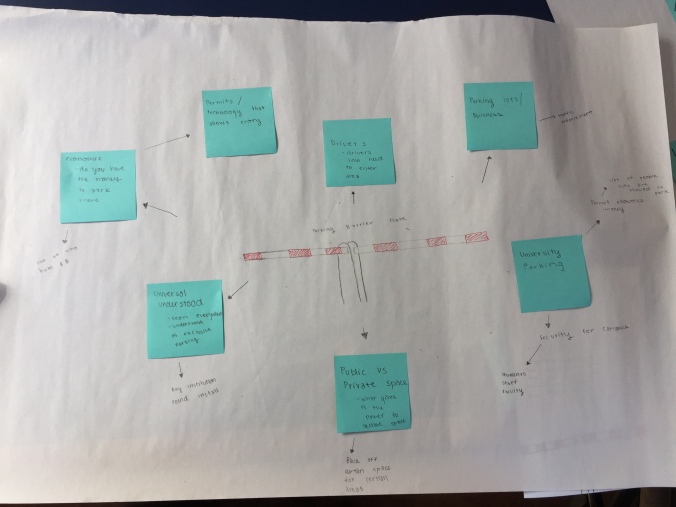
Sociotechnical Map

This is my first sketch changing the parking gate from an authoritative technology into a democratic technology. Changing the design of the gates to allow anyone to enter the parking lot and having drivers pay when they leave makes the technology democratic. This is the same design used in most parking garages which allows any driver to park in an allotted spaces if they have the money to pay for a parking space.
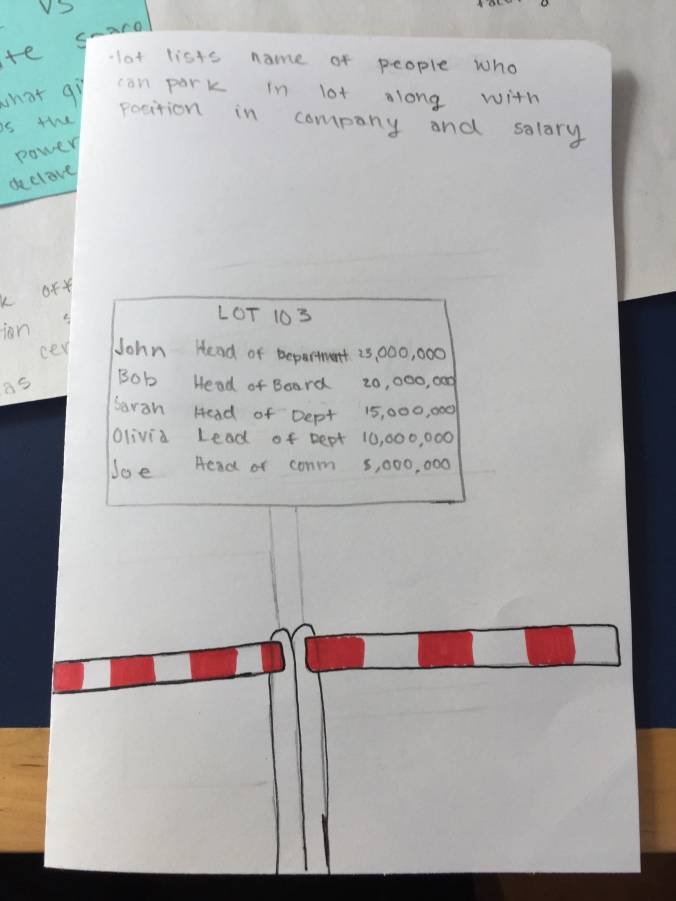
The second technology is bringing attention to the people who are allowed to park in this specific lot. All of these people hold esteemed positions at the University. Their salaries are also displayed to raise awareness for what type of people can use this specific parking lot. This brings attention to who is eligible to park at this specific lot and creates awareness for the politics surrounding this parking lot.
My photographed technology is an authoritative technology because it only allows certain cars to pass through the gates to park in the lot. I think the politics expressed in my photograph came about because of the amount of space available for people to park in on campus. As the amount of staff and students grew at CU the amount of space on campus stayed the same. The parking gates were created to restrict who could park in the limited about of space on campus. Access to these parking lots are normally reserved for people who can afford to pay for a parking spot and those who might hold an important role at the university. My design sketch brings attention to the fact that these gates we see everyday are implicitly representing a system that only allows a certain caliber of person to park within that parking lot. By making a sign stating the drivers’ salary and position allows the public to immediately see the politics involved with these parking lots.
Why Self-driving Cars Need Superhuman Senses
Why Self-driving Cars Need Superhuman Senses Article
The original goal of the article was to “eliminate crashes all together” through automated vehicles perceiving and understanding the world around them. The inverted goal of the cars would be to design a car that aimed to cause car crashes. I had a few imagined technologies.
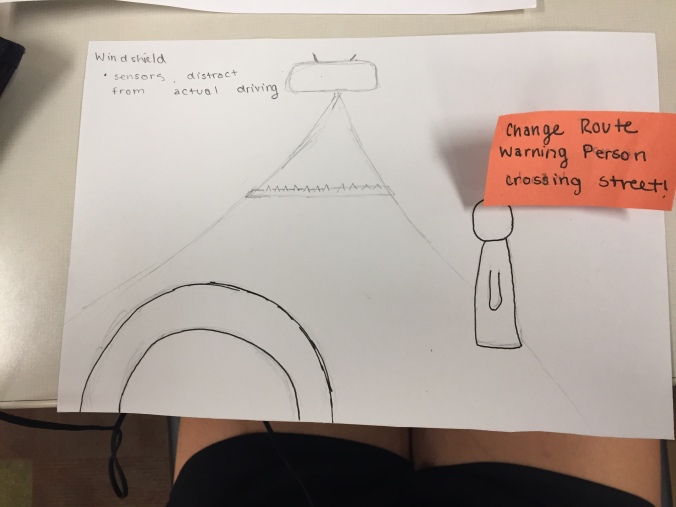
The first imagined technology was the automated car could only sense one object at a time so the automated car doesn’t change the route to avoid getting into a car accident.
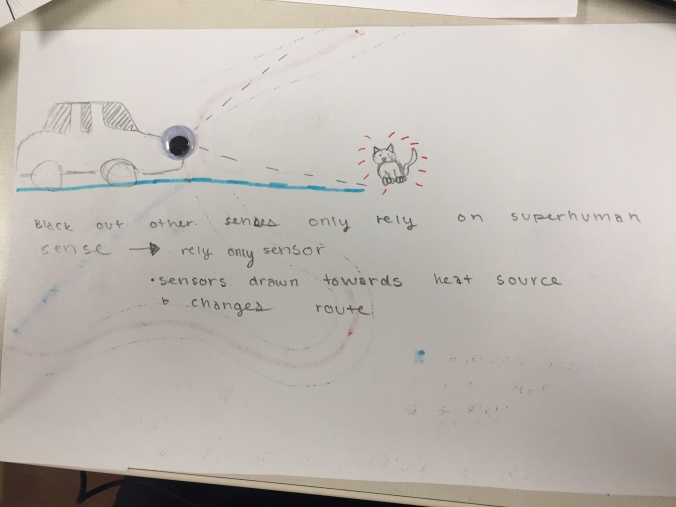
Another technology was the car doesn’t allow steering and other functions so that the only input is coming in from the sensors. When the sensors detect a heat source instead of avoiding it the car moves toward the heat source. This causes people to hit anything giving off a heat source.
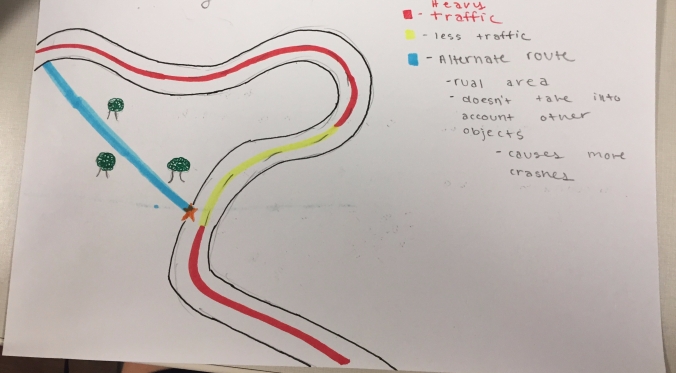
The last technology I thought of was aimed a car designed to get the user to their destination by the fastest route, which includes off-road terrain. The automated car could cause more car accidents in this off-roading system compared to a human because of the difference between human and sensor reaction times. Another technology was the car doesn’t allow steering and other functions so that the only input is coming in from the sensors. When the sensors detect a heat source instead of avoiding it the car moves toward the heat source. This causes people to hit anything giving off a heat source.
The assumption that the opposite goal makes about people is that people want to cause chaos and destruction through not preventing car accidents. These experiences could support the creation of a design that prevents the user from accomplishing these dangerous tasks that cause accidents. The exercise made me realize I had the unconscious biases of assuming everyone has the same desire and resources as the user group I imagined. The inverted technologies gave me the idea of designing a product addressing the opposite goal of the design to see flaws or other options a design team doesn’t traditionally consider. The design supports the reflective design principle of identifying unconscious values and assumptions that are built into the way the problem was conceived. By forcing designers to design an object to address the complete opposite goal of the original design it allows reflection on the fundamental ideas included in the original goal.




